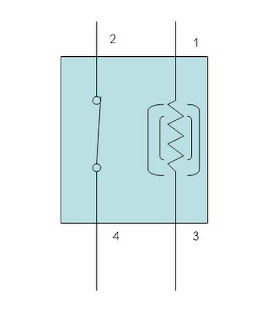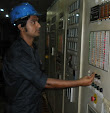Relay
A relay is a protective device that detects the fault and initiates the operation of the circuit breakers to isolate the defective element from the rest of the system.
The relay detects the abnormal condition in the electrical circuit by constantly measuring the electrical quantities which are different under normal and fault condition.
 |
| Relay |
The electrical quantities which may change under fault conditions are voltage, current, frequency and phase change. Though the change in one or more of these quantities, the faults signal their presence, type and location to the protective relays. Having detected fault the relay operates to close the trip circuit of the breaker. This results in to opening of the breaker and disconnection of the faulty circuit.
Basic construction of relay circuit
A relay circuit connection can be divided into three parts
- First part is the primary windings if a current transformer (C.T) which is connected in series with the line to be protected.
- Second part is the primary winding of C.T and the relay opening coil
- Third part is the tripping circuit which may be either a.c or d.c. It consists of a source of supply, the trip coil of the circuit breaker and the relay stationary contacts.
 |
| Parts of relay circuit (3 phase system) |
When a short circuit occurs at a point F on the transmission line, the current flowing in the line increases to and enormous value. This results in a heavy current flow through the relay coil, causing the relay to operate by closing its contacts. This in turn closes the trio circuit of the breaker, making the circuit breaker open and isolating the faulty section from the rest of the system. In this way the relay ensure the safety of the circuit equipments from damage and normal working of the healthy portion of the system.
Fundamental Requirement of a protective relay
The principle function of protective relaying is to ensure the prompt removal form service of any element of the power system when it starts to operate in an abnormal manner or interfere with the effective operation of the rest of the system. In order to protective relay system may perform this function satisfactorily, it should be have the following qualities
Selectivity
- Speed
- Sensitivity
- Reliability
- Simplicity
- Economy
Relay operation
All relays operat using the same basic principlw. Relays have two circuit and a load circuit. The control circuit has a small control coil whilw the load circuit has a switch. The coil controls the operation of the switch
Relay Energized(on)
Current flowing through the circuit coil(pin 1 and pin 3) creates a small magnetic field which causes the switch to close, pins 2and 4. The switch, which is part of the load circuit, is used to control an electrical current that may connect to it. Current now flows through pins 2 and 4, when the relay in energized.
 |
| Relay on |
Relay De Energized(off)
When current stop flowing through the control circuit, pins 1 and 3, the relay becomes de-energized. Wighout the magnetic field, the switch opens and current is prevented from flowing through pins 2 and 4. The relay is now off.
 |
| Relay off |
Operation
When no voltage is applied to pin 1, there is no current flow through the coil. No current means no magnetic fuel is developed, and the switch is open. When voltage is supplied to pin 1, current flow through the coil creates the magnetic field needed to close the switch allowing continuity between pins 2 and 4.







